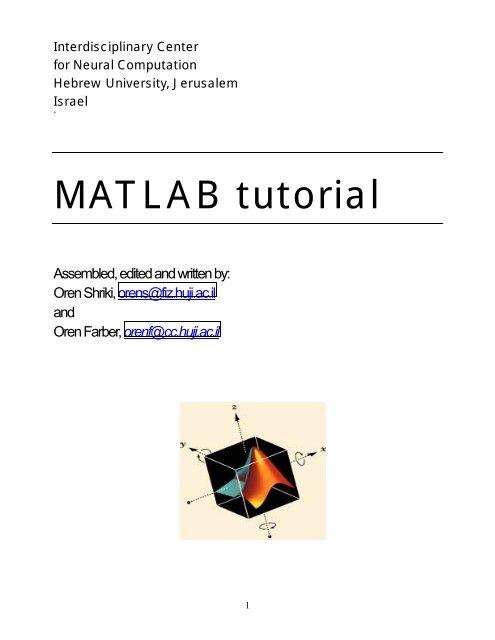

Look up each of these with the help command and practice creating a few of them in the command window. This should yield a 5x5 random matrix with entries between 0 and 1. Since MATLAB is a matrix laboratory, it makes sense that there are many types of matrices built into the program. The exit command can be used to exit a matlab session (you can also use the quit command for the same purpose). You can also ask for help on a specific function by typing help fn (where fn is any matlab function). The help command (as you may have guessed) brings up an online help menu. Some helpful commands to know right away are the help and exit commands. The Command Window is where we will be doing most of our work. (Of course, you may see something slightly different, depending on which version of MATLAB you are using) Once you have opened MATLAB, you will see something like this: This program is incredibly powerful and versatile and can perform a wide variety of operations, but for now we will only focus on the basics necessary for completing the exercises in your training. You can login with username ‘anonymous’ and use your email address as password.MATLAB (for "Matrix Laboratory") is a language and interactive environment for numeric computation, algorithm creation, etc. The data that is used for the tutorials is available from. Plotting data at the channel and source level.Specifying the channel layout for plotting.Multivariate analysis of MEG/EEG data (based on the MVPA light toolbox).Multivariate analysis of MEG/EEG data (based on the Donders Machine Learning Toolbox).Statistical analysis and multiple comparison correction for combined MEG/EEG data.Cluster-based permutation tests on time-frequency data.Cluster-based permutation tests on event related fields.Parametric and non-parametric statistics on event related fields.Whole brain connectivity and network analysis (2) - EEG.Whole brain connectivity and network analysis.Extended analysis of sensor- and source-level connectivity.Analysis of sensor- and source-level connectivity.Preprocessing and averaging of multi-channel NIRS data.Preprocessing and averaging of single-channel NIRS data.Preprocessing and analysis of spike and local field potential data.Preprocessing and analysis of spike-train data.Channel and source analysis of mouse EEG.Analysis of human ECoG and sEEG recordings.Virtual channel analysis of epilepsy MEG dataĪnalysis of intracranial electrophysiological recordings.


#Matlab tutorial trial
Preprocessing - Trigger based trial selection.Preprocessing - Reading continuous EEG and MEG data.Speeding up your analysis with distributed computing.Making a memory efficient analysis script.When adding or contributing to the tutorials please consider the documentation guidelines. Furthermore, we use these tutorials during the various workshops.įor information on what types of datasets we have here on FieldTrip, and which datasets are used in which tutorials see this overview of the datasets used in the tutorials. Some of these tutorials are also used during the “Advanced EEG/MEG analysis” toolkit course that is presented at the Centre for Cognitive Neuroimaging of the Donders Institute for Brain, Cognition and Behaviour each year. The frequently asked questions and example scripts are other forms of documentation.
#Matlab tutorial code
The tutorials contain background on the different analysis methods and include code that you can copy-and-paste in MATLAB to walk through the different analysis options.


 0 kommentar(er)
0 kommentar(er)
